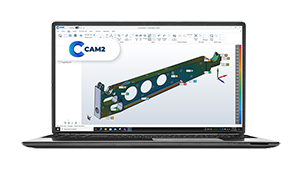Geometry Measurement with CAM2
Overview
The purpose of this article is to advise on the method required to measure features, using a FaroArm® or Laser Tracker.
Download a PDF of this procedure:
Introduction
|
When measuring with a ball probe or Spherically Mounted Retroreflector (SMR), a reading is taken in the center of the probe each time the green button or G key is pressed. This means that the reading taken is offset from the surface probed, and is known as Probe Offset. |
 |
|
To ensure the correct position or size of a feature is calculated, the reading must be projected by the probe radius, to the surface probed. This transfer of the point from the center of the probe to the correct location is known as Probe Compensation. Probe compensation is applied once all readings have been taken, by moving the probe or SMR perpendicular to the surface probed, and then pressing the red button or H key. |
 |
2D Geometry
Consists of the following features:

These require a projection plane where each reading taken, will be projected, to create the 2D feature.

3D Geometry
Consists of the following features:

These do not require a projection plane.
Minimum and Recommended Readings
Each feature requires a minimum number of readings to be taken, to enable that geometry to be calculated and calculated by CAM2. The table below details the minimum and recommended number of readings for each geometry type.
| Feature | Minimum Number of Readings | Recommended Number of Readings |
|---|---|---|
| Plane | 3 | 7 |
| 2D Line | 2 | 5 |
| Circle | 3 | 7 |
| Round Slot | 6 | 13 |
| Rectangular Slot | 6 | 13 |
| Ellipse | 5 | 11 |
| Cylinder | 6 | 13 |
| Cone | 6 | 13 |
| Sphere | 4 | 9 |
| Torus | 8 | 17 |
| Paraboloid | 8 | 17 |
Along with the number of readings, the distribution of readings is also important to ensure the correct calculations. The images below show the suggested distribution of points during measurement. The numbered points show the recommended distribution is using the minimum required
- Line

- Plane

- Circle

- Round Slot

- Rectangular Slot

- Ellipse

- Cylinder

- Cone

- Sphere

- Torus

- Paraboloid

Additional information
Axis Direction
In most cases, the Readings in conjunction with the Probe Compensation point are sufficient to deterministically calculate the actual positions, orientations and dimensions of the geometry that is being measured. There are some geometries where although the axis orientation is deterministic, the direction positive of that axis cannot be inferred from the measurement data alone. In such cases, the resulting geometry will follow the direction defined by the first two readings during the measurement. Below we describe such cases and how the ambiguity is resolved:
- Line: The Readings of the line and the associated projection plane can be used to determine the position and orientation of the line in space however if we consider that the operator may take points randomly along the line, the direction of the line is subject to interpretation. CAM2 will make the resulting line match the direction from the first Readings to the second Reading, in the order in which they are measured. Subsequent points will not affect the direction of the line but only its orientation in space.

- Round / Rectangular Slot: Like the Line, the direction of the axis of these geometries is also not deterministic when only considering the random distribution of Readings in space. The same rule will apply in these cases where the direction of the first Reading to the second is used to determine the direction of the geometry Axis.

- Cylinder: The axis direction of the Cylinder is also subject to interpretation as operators may move up and down the cylinder when they measure it. The line from the first to the second Reading will once more be used to determine the correct direction of the Cylinder axis.

Feature size
In most cases the captured readings, in conjunction with the Probe Compensation points are sufficient to deterministically calculate the feature size. There are however some geometries where certain characteristics of size are not deterministic:
- Plane: The plane area is calculated to the extremities of the captured readings, regardless of measurement order. This is for display purposes only and will be shown as a rectangle. The orientation is displayed parallel to the active coordinate system axis, and perpendicular to the planes vector direction.

- Line: The line length is calculated to the extremities of the captured readings, regardless of measurement order.

- Cylinder: The cylinder length is calculated to the extremities of the captured readings, based upon the axis orientation, regardless of measurement order.

- Cone: The cone length is calculated from the apex to the extremities of the captured readings, based upon the axis orientation, regardless of measurement order.

See Also
Keywords:
Help Sheet, MS001

